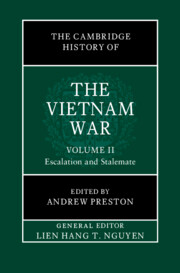Book contents
- The Cambridge History of the Vietnam War
- The Cambridge History of the Vietnam War
- The Cambridge History of the Vietnam War
- Copyright page
- Contents
- Figures
- Maps
- Tables
- Contributors to Volume II
- General Introduction
- Introduction
- Part I Battlefields
- Part II Homefronts
- 14 Dominoes Abroad and at Home
- 15 LBJ, the Great Society, and Vietnam
- 16 Politics in South Vietnam, 1963–1968
- 17 Domestic Politics in the Democratic Republic of Vietnam, 1963–1968
- 18 The Antiwar Movement in the United States
- 19 Vietnam and American Race Relations
- 20 Prowar Sentiment in the United States
- 21 The US News Media and Vietnam
- 22 The South Vietnamese Homefront
- 23 The North Vietnamese Homefront
- Part III Global Vietnam
- Index
21 - The US News Media and Vietnam
from Part II - Homefronts
Published online by Cambridge University Press: 02 January 2025
- The Cambridge History of the Vietnam War
- The Cambridge History of the Vietnam War
- The Cambridge History of the Vietnam War
- Copyright page
- Contents
- Figures
- Maps
- Tables
- Contributors to Volume II
- General Introduction
- Introduction
- Part I Battlefields
- Part II Homefronts
- 14 Dominoes Abroad and at Home
- 15 LBJ, the Great Society, and Vietnam
- 16 Politics in South Vietnam, 1963–1968
- 17 Domestic Politics in the Democratic Republic of Vietnam, 1963–1968
- 18 The Antiwar Movement in the United States
- 19 Vietnam and American Race Relations
- 20 Prowar Sentiment in the United States
- 21 The US News Media and Vietnam
- 22 The South Vietnamese Homefront
- 23 The North Vietnamese Homefront
- Part III Global Vietnam
- Index
Summary
This chapter analyzes what New York Times correspondent David Halberstam called “a war within a war,” the conflict between journalists who reported about the deficiencies of the Saigon government or the US war effort in Vietnam and administration officials in the Kennedy, Johnson, and Nixon administrations who considered those stories myopic or malicious. It argues that news media coverage of the Vietnam War rankled presidents not because it was slanted or sensational but because it showed the hard realities, high costs, and inconvenient truths of a controversial war. As polls revealed declining popular support for the US war effort, it became politically expedient for Johnson and Nixon to blame the news media – and especially the television networks – for public discontent. The “war within the war” has had enduring legacies. The efforts of Kennedy, Johnson, and Nixon to discredit the reporting of television journalists, prominent columnists, and newspaper correspondents established precedents that a later generation of government officials has used in 21st-century battles over “fake news.” Like so much of the US experience in Vietnam, the disputes over the reporting of the war remain part of the present, even as they recede further into the past.
Keywords
- Type
- Chapter
- Information
- The Cambridge History of the Vietnam War , pp. 450 - 471Publisher: Cambridge University PressPrint publication year: 2024

